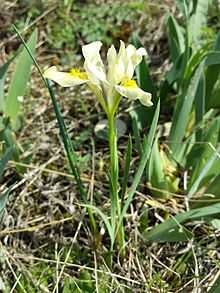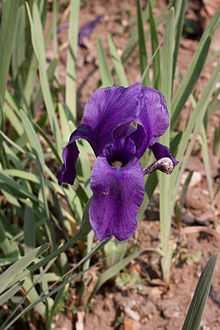Iris subg. Iris
| Iris subgenus Iris | |
|---|---|
 | |
| Purple Bearded Iris | |
| Scientific classification | |
| Kingdom: | Plantae |
| (unranked): | Angiosperms |
| (unranked): | Monocots |
| Order: | Asparagales |
| Family: | Iridaceae |
| Subfamily: | Iridoideae |
| Tribe: | Irideae |
| Genus: | Iris |
| Subgenus: | Iris |
| Series | |
|
See text. | |
Subgenus Iris is one subgenus of Iris, The genus was originally clasified by Carl Linnaeus, but then further organised by Brian Mathew between 1981 and 1987.[1]
It has been divided into six sections; Bearded irises (or pogon irises), Psammiris, Oncocylclus, Regelia, Hexapogon and Pseudoregelia.
Section Bearded irises (or pogon irises)
This is the largest section of the subgenus. Most irises come from Southern or eastern Europe.[1] Note 'pogon' refers to the Greek word for beard.[2] It has several species of iris including;
|
|

It also includes thousands of hybrids which have been divided into various height categories.[3]
- MDB - Miniature Dward bearded
- SDB - Standard Dwarf bearded
- IB - Intermediate bearded
- BB - Border bearded
- MTB - Miniature Tall bearded
- TB - Tall bearded
Psammiris
This section of irises was first described by Spach. Irises from Russia and Northwest china. Mostly rhizomatous, and flowering in late spring.[1] Note psammos derives from the Greek word for sand.[2]

- Iris bloudowii Bunge.
- Iris curvifolia Zhao[4]
- Iris humilis Georgi
- Iris kamelinii Alexeeva
- Iris mandschurica Maxim.
- Iris potaninii Maxim.
- Iris vorobievii N.S.Pavlova
Oncocylus

All irises are rhizomatous perennials. They also generally need rich soils that drain easy and are in full sun. Most also prefer a dry period after flowering.[5] Irises mostly from Turkey, Caucasus and Iran. The flowers usually only have one flower. Some of these species have been bred with bearded irises to create unique colours and markings.[1] Oncocyclus is a Greek word, with onco meaning mass, or bulk, and cyclus meaning circle.[6]
- Iris acutiloba C.A.Mey. (including I. ewbankiana
- Iris assadiana Chaudhary, Kirkw. & C.Weymolauth
- Iris aurantiaca Dinsmore
- Iris atrofusca Bak.
- Iris atropurpurea Bak.
- Iris barnumae Bak. & Fost.
- Iris bismarckiana Reg. – Nazareth Iris
- Iris bostrensis Mouterde
- Iris camillae Grossh.
- Iris gatesii Foster
- Iris haynei (Bak.) Mallet. – Gilboa Iris
- Iris hermona Dinsmore – Hermon Iris
- Iris iberica Hoffm.
- Iris iberica subsp. elegantissima (Sosn.) Fed. & Takht.
- Iris iberica subsp. lycotis (Woronow) Takht.
- Iris kirkwoodi (including I. calcarea)
- Iris lortetii Barbey ex Boiss.
- Iris mariae Barbey.
- Iris meda Stapf
- Iris paradoxa Steven
- Iris petrana Dinsm.
- Iris polakii Stapf
- Iris sari Schott ex Bak.
- Iris sofarana Fost.
- Iris susiana L. – Mourning Iris
Regelia

Mostly from the mountainous regions of Iran, Afghanistan and the Altai Mountains.[7] Most irises have a stem that has 2 flowers.[1] It was named in 1904 by Robert Lynch in his book 'The Book of The Iris' after Dr Regel.[8]
- Iris afghanica Wend
- Iris darwasica Regel
- Iris heweri Grey-Wilson & B. Mathew
- Iris hoogiana Dykes
- Iris kuschkensis Grey-Wilson & B. Mathew
- Iris lineata Foster ex Regel
- Iris korolkowii Regel
- Iris stolonifera Maxim.
Hybrids of Regelia irises and Oncocyclus irises are known as 'Regelicyclous'.[9]
Hexapogon
Mostly from the desert area of Central Asia, Iran and Afghanistan. Most irises have beards on the falls and standards.[1] Note 'hexa' refers to the number 6 and 'pogon' refers to the Greek word for beard.[2]
- Iris falcifolia Bunge
- Iris longiscapa Ledeb.
Pseudoregelia
Mostly from the mountainous regions of Eastern Asia. Most irises have flowers that have blothes or colour spots on.[1]
- Iris goniocarpa Bak.
- Iris hookeriana Fost.
- Iris ivanovae Doronkin
- Iris kamaonensis Wall.
- Iris leptophyll Lingelsheim
- Iris sikkimensis Dykes
- Iris tigrida Bunge ex Ledeb.
References
- ↑ 1.0 1.1 1.2 1.3 1.4 1.5 1.6 Stebbings, Geoff (1997). The Gardener's Guide to Growing Irises. Newton Abbot: David and Charles. p. 18. ISBN 0715305395.
- ↑ 2.0 2.1 2.2 Stearn, William (1972). A Gardenerer's Dictionary of Plant Names. London: Cassell. p. 211. ISBN 0304937215.
- ↑ Morris, Jim (2011). "Bearded Iris Classifications". www.irises.org (American Iris Society). Retrieved 24 July 2014.
- ↑ British Iris Society A Guide to Species Irises: Their Identification and Cultivation, p. 60, at Google Books
- ↑ Christopher Brickell RHS Encyclopedia of Plants and Flowers, p. 521, at Google Books
- ↑ Saad, Layla; Khuri, Sawsan (4 August 2003). "Hanging in There by a Fall – The Oncocyclus Irises of Lebanon" (pdf). orbi.ulg.ac.be. Retrieved 23 July 2014.
- ↑ Cassidy, G.E.; Linnegar, S. (1987). Growing Irises (Revised ed.). Bromley: Christopher Helm. pp. 144–145. ISBN 0-88192-089-4.
- ↑ "The book of the iris, by R. Irwin Lynch". www.biodiversitylibrary.org. p. 116. Retrieved 24 July 2014.
- ↑ Christopher Brickell RHS Encyclopedia of Plants and Flowers, p. 610, at Google Books